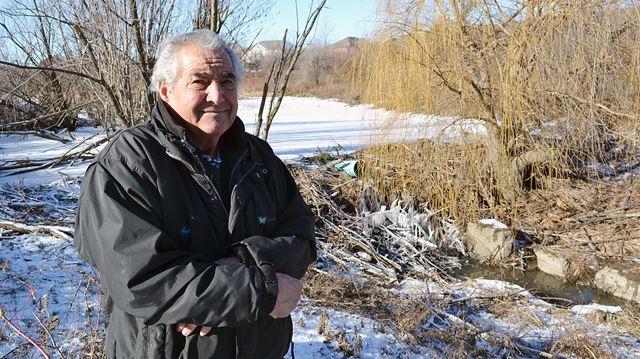It was such a big story yesterday they sent their news cameras to the scene of the crime. Mostly cries if vandalism, but you gotta’ love that resident who suggest “PROTECTING THE IMPORTANT TREES”. For some reason late December-early January has always been a tree chewing time. I remember our beavers gnawing several trees every new year’s without taking anything down. It seemed so wasteful and I thought their ‘forest’ looked a like most people’s living rooms the day after new years – Empty bottles piled up like dead soldiers.
Apparently it happens all over at this time of year. I guess they just get restless and need something toothy to gnaw. Or they need to sharpen their teeth before mating. Here’s a similar report from Brampton, Ontario.
Beavers become gnawing problem for Brampton residents
Call it an epic struggle between man and beast. The man is Giuseppe (Joe) Vommaro on behalf of his Mountainberry Road neighbours.
The beast?
A colony of beavers that has gnawed down trees, built dams and, according to residents, exposed homeowners living along Stephen Llewellyn Trail in Springdale to the risk of flooding.
“We have a big, big problem here,” said Vommaro, one of several residents at odds with the City of Brampton on what to do with these unwanted neighbours.
big, big problem here,” said Vommaro, one of several residents at odds with the City of Brampton on what to do with these unwanted neighbours.
Residents want the dam destroyed and the beavers evicted. But the wildlife and dam are protected. Rather than euthanize or toss the beavers out, the city’s animal services department has taken several measures to encourage the beavers to move out on their own like wrapping trees with mesh wire.
“That’s not good enough,” said Vommaro, complaining city officials have been slow to react to residents’ concerns. He argued the city has left homeowners to deal with the wildlife problem it helped create.
Beavers moved into the neighbourhood in 2011 after the city moved to “re-naturalize” the stormwater channel that runs between Mountainberry Road and Sandalwood Parkway, just west of Airport Road.
It was soon after city crews planted trees and made other changes that neighbours say beavers moved in and made quick work of the landscape.
Dammed off by wood and brush, the once flowing channel has transformed into a wetland and presented homeowners with some unique challenges.
Oh no! They made a wetland? You mean to say those beavers have created one of the most important environment’s on earth in just a few short months? No wonder you’re outraged. Let me just say one thing to Mr. Vommaro. Wrapping trees isn’t supposed to make the beavers “leave”, or the trees leave, or you leave even It’s just supposed to make them less accessible. Did any of your wrapped trees get chewed? Just asking.
Mr, Vommaro and his neighbors are now complaining the flooded vegetation stinks like excrement and no one wants to barbecue anymore. Plus all that water will bring more mosquitoes! Something must be done right away.
Animal services crews are scheduled to return in the spring to get a better handle on whether these measures are enough to encourage the beavers to move on.
Vommaro said without a lasting solution to the problem —reverting the trail to its pre-2011 state — beavers will continue to be a gnawing problem for residents of this Springdale neighbourhood.
Ahhh a true ecologist! Return the area to its prenaturalized state by adding more concrete and maybe the beavers will stay out. Or you know you could just install a flow device and drain some of that water away. But that would be actually solving the problem. You obviously don’t want to do anything like that.
Let me tell you a little story I heard about a city very far away. Their creek and Marina were damaged with chemicals and riprap. And some people worked very, very hard for half a century to get it restored. As soon as they finished some beavers moved in. Just like that. People were very surprised. But a very wise man said to me that it was a stamp of approval for all their hard work. He knew the beavers were a reward for a job well done. But some curmudgeons like you said it was icky and the beavers needed to be gotten rid of.
If you want to know what happened next read ‘our story’. And if you want to know who the very wise man was click here.







 something unusual happening came in autumn after a month of no rain when I measured the water level. I do this at least once a week downstream from our cabin and was surprised to find that instead of dropping an inch or so, it had actually risen 2 inches. I attributed it to mismeasurement until I took my walk.
something unusual happening came in autumn after a month of no rain when I measured the water level. I do this at least once a week downstream from our cabin and was surprised to find that instead of dropping an inch or so, it had actually risen 2 inches. I attributed it to mismeasurement until I took my walk.






































